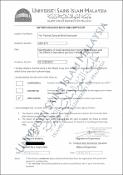Options
Identification Of Oral Bacteria From Subgingival Plaque And The Effect Of Salvadora Persica Extracts On The Growth
Date Issued
2023-04
Author(s)
Nur Fatimah Zaharah Salehuddin
Abstract
Oral diseases are commonly found in the human population caused by the accumulation
of bacterial plaque. There is still lacking of study regarding types of oral bacteria in the
Malaysian population. Streptococcus mutans (S. mutans) is one of oral streptococci
which initiate periodontal disease as an early colonizer. Over time, Gram-negative
anaerobes become more established, especially Porphyromonas gingivalis (P.
gingivalis). Nevertheless, bacteria can develop antibiotic resistance to medicinal drugs
over time. However, Salvadora persica (S. persica) or known as miswak is
acknowledged significantly due to the presence of bioactive compounds that contain
inhibitory activity against oral bacteria. The main objective in this study is to identify
oral bacteria from subgingival plaque and determine the antibacterial activities of
Salvadora persica Stem Extracts (SPSE) against selected oral bacteria. The specific
objective of this study is to identify the type of oral bacteria in subgingival plaque using
16S rRNA sequencing, to determine the antibacterial activities of SPSE against selected
oral bacteria and to investigate the phytochemistry compositions of SPSE using Gas
Chromatography Mass Spectrometry (GCMS). This study successfully isolated 176 oral
bacteria from 10 subgingival plaque samples. A total of 17 oral bacteria had been
identified from all samples. About 97 Gram-negative bacteria were successfully
isolated from all samples. The majority of the bacteria are Gram-positive which is
Streptococcus species and others are Gram-negative bacteria, including P. gingivalis,
A. actinomycetemcomitans and K. pneumoniae. SPSE were produced using n-hexane,
DCM, acetone, ethanol, and methanol. Antibacterial activities of SPSE-n-hexane,
SPSE-DCM, SPSE-acetone, SPSE-ethanol, and SPSE-methanol were determined by
performing three different techniques, such as disc diffusion assay (DDA), minimum
inhibitory concentration (MIC) and minimum bactericidal concentration (MBC) against
S. mutans and P. gingivalis. Gas chromatography mass spectrometry (GCMS) was
analysed to investigate the phytochemistry composition in SPSE that can inhibit the
growth of S. mutans and P. gingivalis. From the results, there is a significant difference
between the type of solvents used in SPSE and the diameter of the inhibition zone for
S. mutans and P. gingivalis (p < 0.001). For MIC results, S. mutans were inhibited with
SPSE-n-hexane at 3.125 mg/mL. Meanwhile, S. mutans were killed with 6.25 mg/mL
of SPSE-n-hexane. In GCMS analysis, the major phytochemical of all extracts was
benzoic acid, hexadecanoic acid and octadecanoic acid. In conclusion, S. persica is
highly recommended as one of the oral hygiene tools to treat oral diseases due to its
effectiveness in inhibiting the growth of oral bacteria.
of bacterial plaque. There is still lacking of study regarding types of oral bacteria in the
Malaysian population. Streptococcus mutans (S. mutans) is one of oral streptococci
which initiate periodontal disease as an early colonizer. Over time, Gram-negative
anaerobes become more established, especially Porphyromonas gingivalis (P.
gingivalis). Nevertheless, bacteria can develop antibiotic resistance to medicinal drugs
over time. However, Salvadora persica (S. persica) or known as miswak is
acknowledged significantly due to the presence of bioactive compounds that contain
inhibitory activity against oral bacteria. The main objective in this study is to identify
oral bacteria from subgingival plaque and determine the antibacterial activities of
Salvadora persica Stem Extracts (SPSE) against selected oral bacteria. The specific
objective of this study is to identify the type of oral bacteria in subgingival plaque using
16S rRNA sequencing, to determine the antibacterial activities of SPSE against selected
oral bacteria and to investigate the phytochemistry compositions of SPSE using Gas
Chromatography Mass Spectrometry (GCMS). This study successfully isolated 176 oral
bacteria from 10 subgingival plaque samples. A total of 17 oral bacteria had been
identified from all samples. About 97 Gram-negative bacteria were successfully
isolated from all samples. The majority of the bacteria are Gram-positive which is
Streptococcus species and others are Gram-negative bacteria, including P. gingivalis,
A. actinomycetemcomitans and K. pneumoniae. SPSE were produced using n-hexane,
DCM, acetone, ethanol, and methanol. Antibacterial activities of SPSE-n-hexane,
SPSE-DCM, SPSE-acetone, SPSE-ethanol, and SPSE-methanol were determined by
performing three different techniques, such as disc diffusion assay (DDA), minimum
inhibitory concentration (MIC) and minimum bactericidal concentration (MBC) against
S. mutans and P. gingivalis. Gas chromatography mass spectrometry (GCMS) was
analysed to investigate the phytochemistry composition in SPSE that can inhibit the
growth of S. mutans and P. gingivalis. From the results, there is a significant difference
between the type of solvents used in SPSE and the diameter of the inhibition zone for
S. mutans and P. gingivalis (p < 0.001). For MIC results, S. mutans were inhibited with
SPSE-n-hexane at 3.125 mg/mL. Meanwhile, S. mutans were killed with 6.25 mg/mL
of SPSE-n-hexane. In GCMS analysis, the major phytochemical of all extracts was
benzoic acid, hexadecanoic acid and octadecanoic acid. In conclusion, S. persica is
highly recommended as one of the oral hygiene tools to treat oral diseases due to its
effectiveness in inhibiting the growth of oral bacteria.
File(s)

Loading...
Name
3201478 Declaration..pdf
Size
254.24 KB
Format
Adobe PDF
Checksum
(MD5):725731347fcbb18bf8480c6060163582
Loading...
Name
3201478 Introduction.pdf
Size
476.19 KB
Format
Adobe PDF
Checksum
(MD5):12cfb3e2111b0ee8d048dcff4068846c